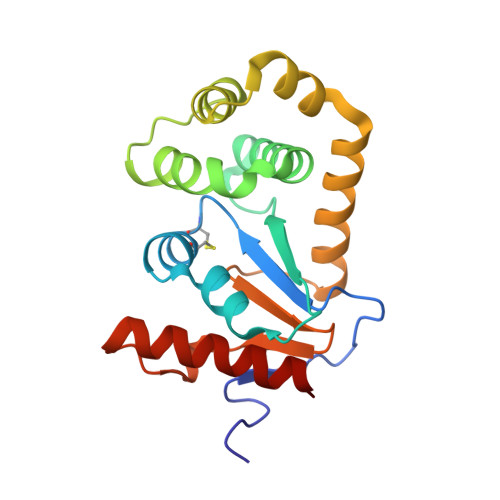Inhibition of Diverse DsbA Enzymes in Multi-DsbA Encoding Pathogens.
Totsika, M., Vagenas, D., Paxman, J.J., Wang, G., Dhouib, R., Sharma, P., Martin, J.L., Scanlon, M.J., Heras, B.(2018) Antioxid Redox Signal 29: 653-666
- PubMed: 29237285
- DOI: https://doi.org/10.1089/ars.2017.7104
- Primary Citation of Related Structures:
6BQX, 6BR4 - PubMed Abstract:
DsbA catalyzes disulfide bond formation in secreted and outer membrane proteins in bacteria. In pathogens, DsbA is a major facilitator of virulence constituting a target for antivirulence antimicrobial development. However, many pathogens encode multiple and diverse DsbA enzymes for virulence factor folding during infection. The aim of this study was to determine whether our recently identified inhibitors of Escherichia coli K-12 DsbA can inhibit the diverse DsbA enzymes found in two important human pathogens and attenuate their virulence. DsbA inhibitors from two chemical classes (phenylthiophene and phenoxyphenyl derivatives) inhibited the virulence of uropathogenic E. coli and Salmonella enterica serovar Typhimurium, encoding two and three diverse DsbA homologues, respectively. Inhibitors blocked the virulence of dsbA null mutants complemented with structurally diverse DsbL and SrgA, suggesting that they were not selective for prototypical DsbA. Structural characterization of DsbA-inhibitor complexes showed that compounds from each class bind in a similar region of the hydrophobic groove adjacent to the Cys30-Pro31-His32-Cys33 (CPHC) active site. Modeling of DsbL- and SrgA-inhibitor interactions showed that these accessory enzymes could accommodate the inhibitors in their different hydrophobic grooves, supporting our in vivo findings. Further, we identified highly conserved residues surrounding the active site for 20 diverse bacterial DsbA enzymes, which could be exploited in developing inhibitors with a broad spectrum of activity. Innovation and Conclusion: We have developed tools to analyze the specificity of DsbA inhibitors in bacterial pathogens encoding multiple DsbA enzymes. This work demonstrates that DsbA inhibitors can be developed to target diverse homologues found in bacteria. Antioxid. Redox Signal. 29, 653-666.
- 1 Institute of Health and Biomedical Innovation, School of Biomedical Sciences, Queensland University of Technology , Queensland, Australia .
Organizational Affiliation:

















